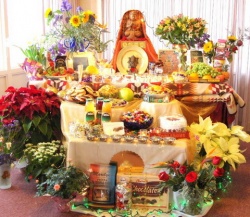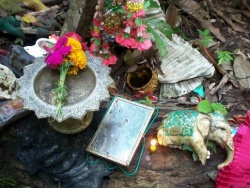Offering
In Buddhism, symbolic offerings are made to the Triple Gem, giving rise to contemplative Gratitude and inspiration. Typical material offerings involve simple objects such as a lit candle or oil lamp, burning Incense, Flowers, Food, fruit, water or drinks.
Contemporary Western practitioners often find the making of offerings to be occasions for gracious Mindfulness. Within the traditional Buddhist framework of Karma and Rebirth, offerings also lead to:
a better Rebirth in the cycle of birth and Death (Pali: vattagamini-kusala)
progress towards release from Suffering (Pali: vivattagamini-kusala).
These offerings often act as preparation for Meditation.
Theravada practices
Material offerings nurture Generosity (Pali:Dāna) and virtue (Pali: Sīla).[9] The act further honors the Triple Gem (The Buddha, Dhamma and Sangha), deepening one's commitment to The Buddha's path. For instance, traditional chants (in English and Pali) when offering lit candles (padīpa pūjā) and Incense (sugandha pūjā) to an image of The Buddha are:
With lights brightly shining
Abolishing this gloom
I adore the Enlightened One,
The Light of the three worlds.
With perfumed Incense
And fragrant smoke
I worship the Exalted One,
Who is great and worthy of worship.
Ghanasārappadittena
Dīpena tama-dhaṃsinā
Tiloka-dīpaṃ sambuddhaṃ
Pūjayāmi tamo-nudaṃ
Ghandha-sambhāra-yuttena
Dhūpenāhaṃ sugandhinā
Pūjaye pūjaneyyaṃ taṃ
Pūjābhajanamuttamaṃ
Similarly, a traditional Pali Incense-lighting verse speaks of The Buddha's "fragrant Body and fragrant face, fragrant with infinite virtues."
By contemplating on an offering, one tangibly sees Life's Impermanence (Pali: Anicca), one of the three characteristics of all things upon which The Buddha encouraged his disciplines to recollect. For instance, the end of a traditional chant (in English and Pali) when offering Flowers (puppha pūjā) to an image of The Buddha is:
I worship The Buddha with these Flowers;
May this virtue be helpful for my emancipation;
Just as these Flowers fade,
Our Body will undergo decay.
Pujemi Buddham kusumenanena
Puññenametena ca hotu mokkham
Puppham milāyāti yathā idam me
Kāyo tathā yāti vināsa-bhavam
Mahayana practices
Burning of Incense before the Potala, 1939
Mahayana material offerings might be imbued with the following symbology:
the lighting of a candle or an oil lamp represents the Light of Wisdom illuminating the darkness of Ignorance.
the burning of Incense represents the fragrant scent of morality.
Flowers represents the aspiration to achieve the Body of The Buddha with the thirty-two marks of The Buddha as well as the teaching of Impermanence. Alternately, a Zen verse expresses the desire for the mind's "Flowers" to "bloom in the springtime of Enlightenment."
Food, fruit, water, drinks represents the nectar of Dharma and the wish to achieve it.
In Northern Buddhism, sacred images have set before them:
water (representing Hospitality, to wash the face and feet)
scarves (Tib. kha-btags, offering Friendship)
Flowers, Incense, lamps, perfume and Food (representing one's devoting all their senses to their spiritual practice).
Non-material offerings
In some traditions, two different types of offerings are identified:
material or Hospitality offerings (Pali: amisa-Puja[15] or sakkara-Puja
practice offerings (Pali: patipatti-Puja)
In this context, material offerings are considered external offerings of "words and deeds."
Practice offerings may be manifested by practicing:
giving (Pali: Dāna)
moral conduct (Sīla)
Meditation (Samādhi)
Wisdom (Pañña)
In the Pali Canon, The Buddha declared practice offerings as "the best way of honoring The Buddha" and as the "supreme" offering. This is primarily an internal offering for mental development (Pali: Citta, bhāvanā and Samādhi).



